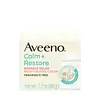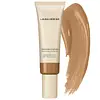What's inside
What's inside
 Key Ingredients
Key Ingredients

 Benefits
Benefits

 Concerns
Concerns

 Ingredients Side-by-side
Ingredients Side-by-side

Water
Skin ConditioningGlycerin
HumectantC12-15 Alkyl Benzoate
AntimicrobialCetearyl Alcohol
EmollientDimethicone
EmollientArachidyl Alcohol
EmollientCetyl Alcohol
EmollientAvena Sativa Kernel Flour
AbrasivePhenyl Trimethicone
Skin ConditioningCetearyl Glucoside
EmulsifyingBehenyl Alcohol
EmollientSodium Polyacrylate
AbsorbentPhenoxyethanol
PreservativePanthenol
Skin ConditioningCaprylyl Glycol
EmollientEthylene/Acrylic Acid Copolymer
Emulsion StabilisingPolyacrylamide
Arachidyl Glucoside
EmulsifyingC13-14 Isoparaffin
EmollientChrysanthemum Parthenium Flower/Leaf/Stem Juice
AntioxidantChlorphenesin
AntimicrobialDisodium EDTA
Pentaerythrityl Tetra-Di-T-Butyl Hydroxyhydrocinnamate
AntioxidantLaureth-7
EmulsifyingCeramide NP
Skin ConditioningWater, Glycerin, C12-15 Alkyl Benzoate, Cetearyl Alcohol, Dimethicone, Arachidyl Alcohol, Cetyl Alcohol, Avena Sativa Kernel Flour, Phenyl Trimethicone, Cetearyl Glucoside, Behenyl Alcohol, Sodium Polyacrylate, Phenoxyethanol, Panthenol, Caprylyl Glycol, Ethylene/Acrylic Acid Copolymer, Polyacrylamide, Arachidyl Glucoside, C13-14 Isoparaffin, Chrysanthemum Parthenium Flower/Leaf/Stem Juice, Chlorphenesin, Disodium EDTA, Pentaerythrityl Tetra-Di-T-Butyl Hydroxyhydrocinnamate, Laureth-7, Ceramide NP
Ethylhexyl Methoxycinnamate
UV AbsorberEthylhexyl Salicylate
UV AbsorberWater
Skin ConditioningDisiloxane
Skin ConditioningPEG-30 Dipolyhydroxystearate
EmulsifyingC12-15 Alkyl Benzoate
AntimicrobialEthylhexyl Palmitate
EmollientGlycerin
HumectantIsohexadecane
EmollientCyclopentasiloxane
EmollientPhenoxyethanol
PreservativeBoron Nitride
AbsorbentJojoba Esters
EmollientMagnesium Stearate
Cosmetic ColorantSodium Dehydroacetate
PreservativeSqualane
EmollientLauryl PCA
HumectantTocopheryl Acetate
AntioxidantMethyl Di-T-Butyl Hydroxyhydrocinnamate
AntioxidantIsopropyl Titanium Triisostearate
EmollientDisodium EDTA
PPG-15
Skin ConditioningPPG-15 Stearyl Ether
EmollientDipotassium Glycyrrhizate
HumectantMethylparaben
PreservativePropylparaben
PreservativeCI 77891
Cosmetic ColorantCI 77492
Cosmetic ColorantCI 77491
Cosmetic ColorantCI 77499
Cosmetic ColorantEthylhexyl Methoxycinnamate, Ethylhexyl Salicylate, Water, Disiloxane, PEG-30 Dipolyhydroxystearate, C12-15 Alkyl Benzoate, Ethylhexyl Palmitate, Glycerin, Isohexadecane, Cyclopentasiloxane, Phenoxyethanol, Boron Nitride, Jojoba Esters, Magnesium Stearate, Sodium Dehydroacetate, Squalane, Lauryl PCA, Tocopheryl Acetate, Methyl Di-T-Butyl Hydroxyhydrocinnamate, Isopropyl Titanium Triisostearate, Disodium EDTA, PPG-15, PPG-15 Stearyl Ether, Dipotassium Glycyrrhizate, Methylparaben, Propylparaben, CI 77891, CI 77492, CI 77491, CI 77499
 Reviews
Reviews

Ingredients Explained
These ingredients are found in both products.
Ingredients higher up in an ingredient list are typically present in a larger amount.
C12-15 Alkyl Benzoate is made up of Benzoic Acid and long chain alcohols. It has a low molecular weight.
C12-15 Alkyl Benzoate is an emollient and texture enhancer. Due to its solubility, it is often used in sunscreens to help evenly distribute active ingredients.
As an emollient, C12-15 Alkyl Benzoate helps soften and hydrate your skin. Emollients create a film on your skin that traps moisture within.
This ingredient has been reported to cause eye irritation.
Learn more about C12-15 Alkyl BenzoateDisodium EDTA plays a role in making products more stable by aiding other preservatives.
It is a chelating agent, meaning it neutralizes metal ions that may be found in a product.
Disodium EDTA is a salt of edetic acid and is found to be safe in cosmetic ingredients.
Learn more about Disodium EDTAGlycerin is already naturally found in your skin. It helps moisturize and protect your skin.
A study from 2016 found glycerin to be more effective as a humectant than AHAs and hyaluronic acid.
As a humectant, it helps the skin stay hydrated by pulling moisture to your skin. The low molecular weight of glycerin allows it to pull moisture into the deeper layers of your skin.
Hydrated skin improves your skin barrier; Your skin barrier helps protect against irritants and bacteria.
Glycerin has also been found to have antimicrobial and antiviral properties. Due to these properties, glycerin is often used in wound and burn treatments.
In cosmetics, glycerin is usually derived from plants such as soybean or palm. However, it can also be sourced from animals, such as tallow or animal fat.
This ingredient is organic, colorless, odorless, and non-toxic.
Glycerin is the name for this ingredient in American English. British English uses Glycerol/Glycerine.
Learn more about GlycerinPhenoxyethanol is a preservative that has germicide, antimicrobial, and aromatic properties. Studies show that phenoxyethanol can prevent microbial growth. By itself, it has a scent that is similar to that of a rose.
It's often used in formulations along with Caprylyl Glycol to preserve the shelf life of products.
Water. It's the most common cosmetic ingredient of all. You'll usually see it at the top of ingredient lists, meaning that it makes up the largest part of the product.
So why is it so popular? Water most often acts as a solvent - this means that it helps dissolve other ingredients into the formulation.
You'll also recognize water as that liquid we all need to stay alive. If you see this, drink a glass of water. Stay hydrated!
Learn more about Water